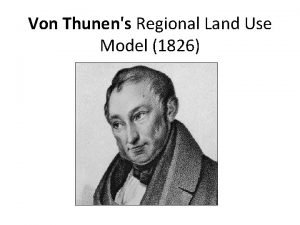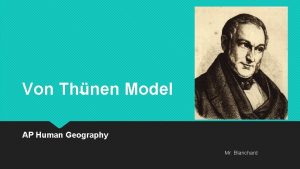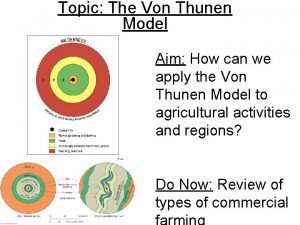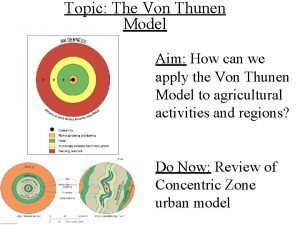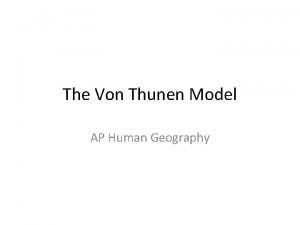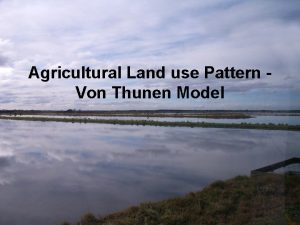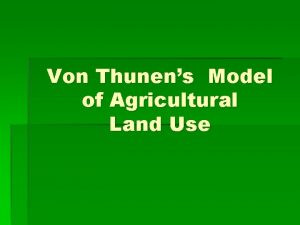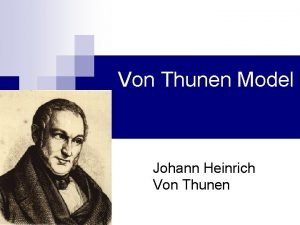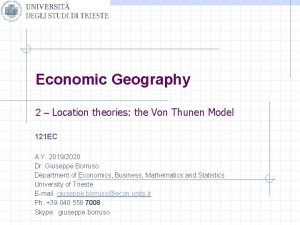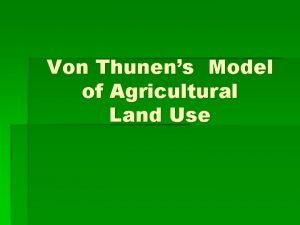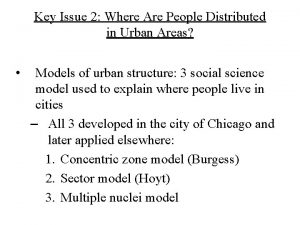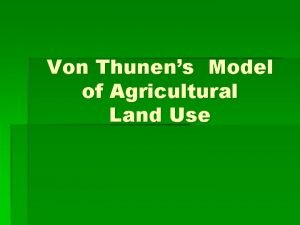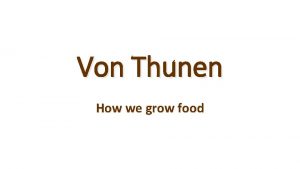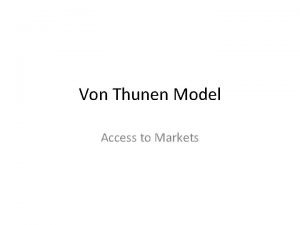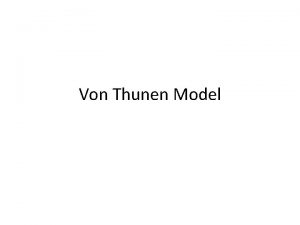Topic The Von Thunen Model Aim How can











- Slides: 11

Topic: The Von Thunen Model Aim: How can we apply the Von Thunen Model to agricultural activities and regions? Do Now: Review of Concentric Zone urban model

Second Agriculture Revolution • A series of innovations, improvements, and techniques used to improve the output of agricultural surpluses (started before the industrial revolution). – seed drill – new crops-potatoes & corn – advances in livestock breeding – new soil preparation methods & new fertilizers

Von Thunen Model: 1. Proposed in 1826 by German farmer Johann Heinrich von Thunen – farmer and economist 2. Helps explain the importance of proximity to market in the choice of crops and animals on commercial farms 3. Commercial farmers compare cost of land to cost of transporting products to market 4. As one gets closer to the city, the price of land increases, and the type of crop produced changes

Von Thunen Model • Von Thunen Model – What farmers produce varies by distance from the town, with livestock raising farthest from town. – Cost of transportation governs use of land. – First effort to analyze the spatial character of economic activity.

Ring 1: Dairying and intensive farming occur • Ring 1: Dairying and intensive farming occur in the ring closest to the city. Since vegetables, fruit, milk and other dairy products must get to market quickly, they would be produced close to the city (no refrigerated oxcarts in 1830 s!)

• Ring 2: Timber and firewood would be produced for fuel and building materials. Ring 1: Before industrialization Dairying and intensive (and coal power), wood farming occur was a very important fuel for heating and cooking. Wood is very heavy and difficult to transport so it’s located as close to city as possible.

Ring 1: Dairying and intensive farming occur • Ring 3: Extensive field crops such as grains for bread occur in this ring. Since grains last longer than dairy products and are much lighter than fuel (reduces transportation costs) they can be located further from the city.

• Ring 4: Livestock ranching is located in the final ring surrounding the central city. Animals can be raised far from the city because they are selftransporting. Animals can walk to the central city for sale or for butchering. • Beyond the fourth ring lies wilderness.

Von Thunen recognized that his model would be modified by site factors, such as a river in this sketch, which changes the accessibility of different land parcels to the market center.

Assumptions/Critiques of Theory • City is located centrally within an “isolated state” which is self-sufficient and has no external influences • Isolated state is surrounded by wilderness • Land is completely flat and no rivers/mountains interrupt the terrain • Soil quality and climate are consistent • Farmers transport their own goods to market via oxcart, across land, directly to central city (therefore no roads)

Application of Von Thunen Model: • Geographer Lee Liu studied the spatial pattern of agriculture production in China. Found: - farmers living in a village farm both lands close to the village and far away intensively - methods varied spatially – resulting in land improvement (by adding organic material) close to village and land degradation (lots of pesticides and fewer conservation tactics) farther from village.
 Von thunen agricultural model
Von thunen agricultural model Von thunen model ap human geography definition
Von thunen model ap human geography definition Con thunen model
Con thunen model Von thunen model rings explained
Von thunen model rings explained Von thunen model examples
Von thunen model examples Von thunen model graph
Von thunen model graph Assumptions of von thunen model
Assumptions of von thunen model Von thunen theory of agricultural location
Von thunen theory of agricultural location Von thunens theory
Von thunens theory Von thunen agricultural model
Von thunen agricultural model Where are people distributed
Where are people distributed Thunens model
Thunens model
